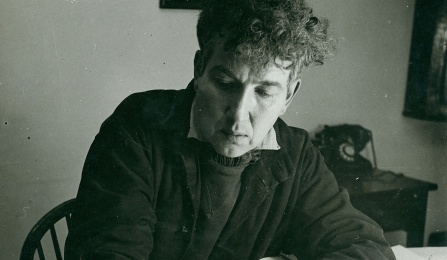Robert Graves Collection Overview

Robert Graves (24 July 1895 – 7 December 1985) was an English poet and novelist who during his lifetime authored more than 140 books of poems, novels, translations, autobiography, poetics and books on myth. He is frequently remembered for his memoir of the First World War Good-bye to All That, his two-volume Greek Myths, his historical study of poetic inspirations The White Goddess and his historical novel I, Claudius. However, above all else Robert Graves considered himself a poet.
Graves was one of the poets originally solicited by Charles Abbott. When a donation by Mildred Lockwood Lacey in 1960 made it possible to acquire the manuscripts of all Graves’ books of poetry and some works in prose published from 1910 until 1959, this extensive archive augmented and extended the collection of British first editions already in the Poetry Collection. There are over 350 publications in the Robert Graves Collection, excluding anthologies, periodical appearances and broadsides. These include among many others the scarce early pamphlets Over the Brazier (1916), Fairies and Fusiliers (1917) and Treasure Box (1919); a signed and numbered copy of The Marmosite’s Miscellany (1925), which Graves wrote under the name of John Doyle; the first and second states of Good-bye to All That (1929, 1957); Poems 1926-1930 (1931); and No More Ghosts (1940). Graves’ later non-fiction and prose works, including the popular novels I, Claudius (1934) and Claudius the God (1934), are also present in various states and editions, as is a copy of the script used for the British Broadcasting Company’s serialization of I, Claudius on television.
In addition to these materials, the Poetry Collection’s Robert Graves Collection contains a large number of Graves’ manuscripts and correspondence. Graves’ habit was to write, revise and rewrite individual poems many times, even after their appearance in print, and they are often written on the verso pages of his prose. Because a single poem can have multiple drafts, the manuscripts for any individual book can consist of hundreds of pages. For example, the poem “The Rock Below” has ten drafts, with seventeen sheets of paper, and each draft contains substantive alterations. Overall, the collection contains manuscripts for over 1,000 poems including the typescripts of several individual pre-World War I and World War I poems as well as from such published collections as The Pier-Glass (1921), The Feather Bed (1923), Whipperginny (1923), Mock Beggar Hall (1924), The Marmosite’s Miscellany (1925) and Welchman’s Hose (1925). As for his prose works, the Graves Collection contains two typescript manuscripts and the author’s corrected 4th-printing copy of the pivotal book Good-bye to All That (1929), with Graves’ revisions and deletions made in preparation for the second edition, and typescripts of Horses: A Play in One Act, The White Goddess (1948), Homer’s Daughter (1955) and Food for Centaurs (1960). Other holdings include his correspondence to Lynette Roberts, which traces the formation of The White Goddess, along with hundreds of other letters to and from various poets; the knapsack Graves used during World War I; a portrait of Graves by John Ulbricht; a sculpture of Graves by Dorothy Simmons; photographs of Graves; and other memorabilia. This collection is supported by the Poetry Collection’s secondary materials, its little magazines and substantial holdings of Laura Riding, featuring a complete set of her first editions as well as manuscripts and letters.
Since 1979 the Robert Graves Collection has been further enriched by the purchase of all the American editions of his books as well as second and other bibliographically important editions. Following the publication of Martin Seymour-Smith’s biography Robert Graves: His Life and Work (1982), the Poetry Collection acquired Seymour-Smith’s working papers, including his notes, photocopies of subsequently missing or destroyed materials, hundreds of letters from Graves and his acquaintances and the unexpurgated version of the biography itself. More recently, the letters of Graves to Sally Chilver, who provided important materials for Graves’ King Jesus (1946), have also been added to the collection, as has Carl Hahn’s Robert Graves first appearance collection.